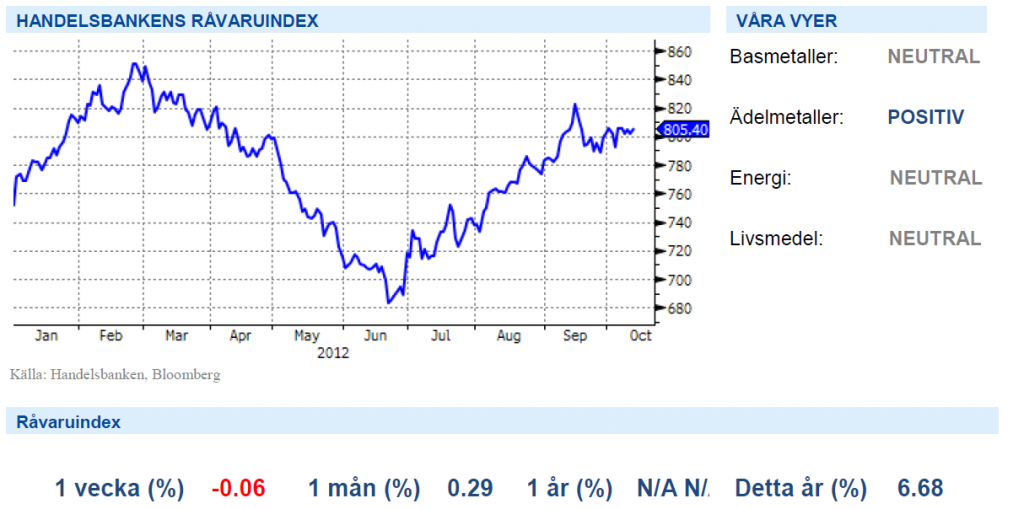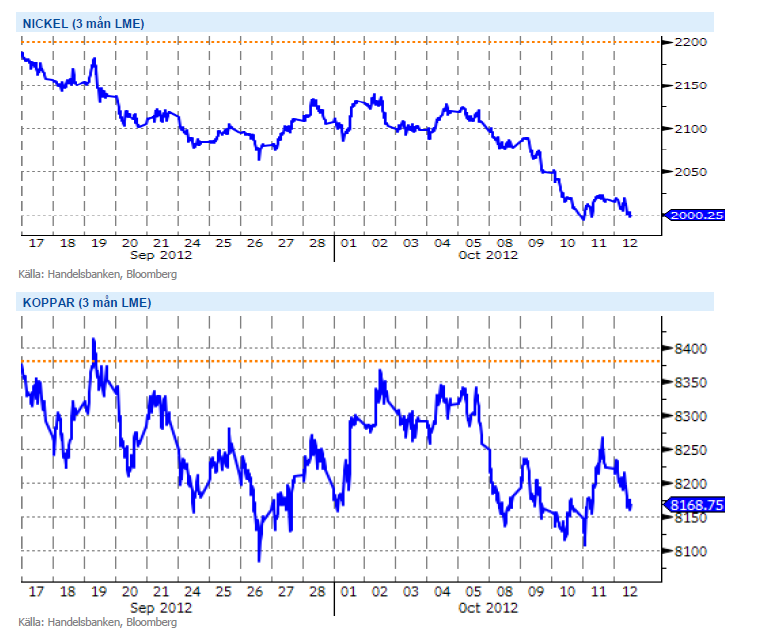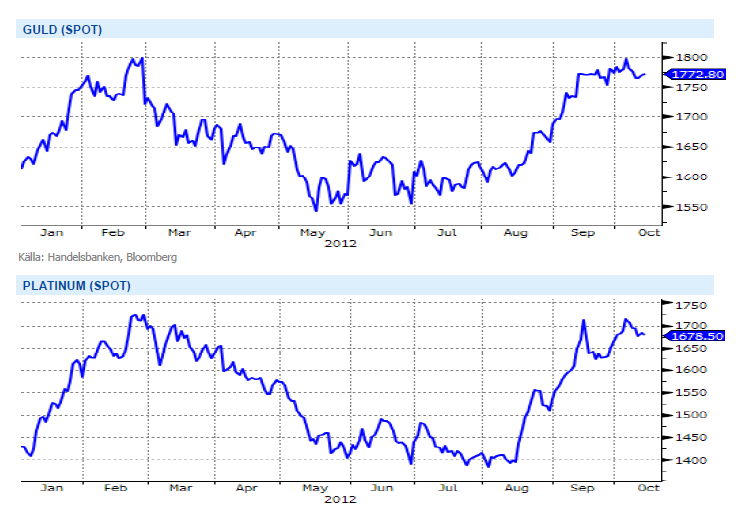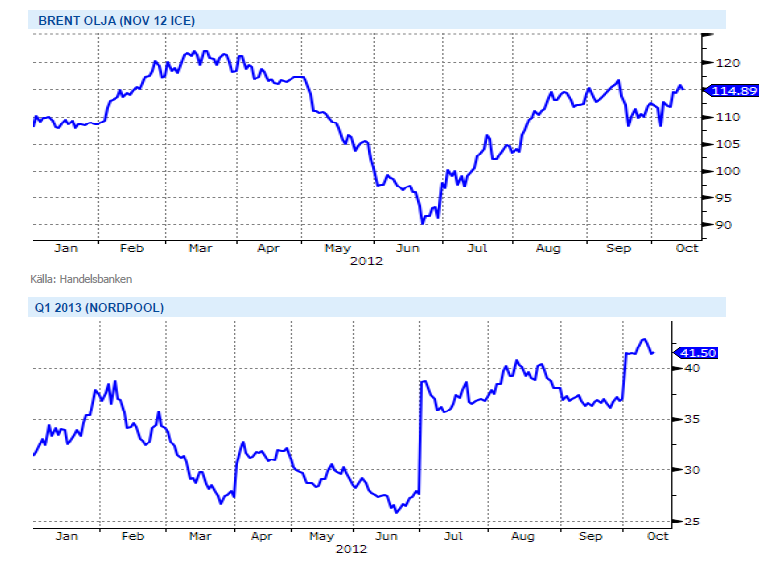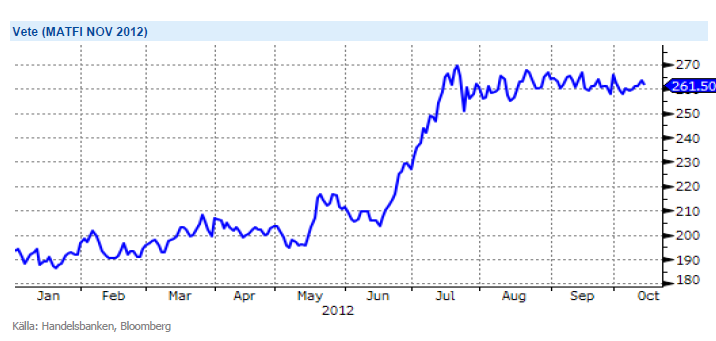Analys
SHB Råvarubrevet 12 oktober 2012
 Riskaptiten har fortsatt att svalna sedan förra veckan även om utvecklingen varierat mellan tillgångsslag. Börser har generellt uppvisat mer svaghet medan råvaror fortsätter att hålla emot. Makrodata har varit blandad med USA i topp och Sverige i botten. En orsak till det svaga risksentimentet är troligen att positioneringen är mer tiltad åt det positiva hållet jämfört med tidigare, vilket bland annat indikeras av måttliga och kortvariga positiva reaktion på stark makrodata.
Riskaptiten har fortsatt att svalna sedan förra veckan även om utvecklingen varierat mellan tillgångsslag. Börser har generellt uppvisat mer svaghet medan råvaror fortsätter att hålla emot. Makrodata har varit blandad med USA i topp och Sverige i botten. En orsak till det svaga risksentimentet är troligen att positioneringen är mer tiltad åt det positiva hållet jämfört med tidigare, vilket bland annat indikeras av måttliga och kortvariga positiva reaktion på stark makrodata.
Basmetallerna
Basmetaller glider uppåt
Basmetallerna har under veckan fallit kraftigt. Mest har zink fallit; ned drygt 6.4 % under veckan. Aluminium, bly och nickel har också fallit kraftigt; ned drygt 5.4 %. Den ”röda konjunkturindikatorn”, koppar hade en relativt ”bra” vecka med en nedgång med endast 1.5 %. Veckan har präglats av olika bud kring vart konjunkturen är på väg. Nickelpriset trycktes ner till följd av en rapport från International Nickel Study Group som spådde en väsentligt högre produktion globalt under 2013. Vi har efter veckans kraftiga prisfall ändrat vår vy till Neutral på basmetaller. Har man fortfarande en vinst så ska man fundera på att ta hem den inom kort.
Klokt att skydda sin basmetallvinst med en stop loss i denna miljö där priserna är så volatila. Vi är neutrala till basmetallerna som helhet.
Ädelmetaller
Ädelmetallerna lite nedåt
Ännu en vecka har gått med väldigt små rörelser, Handelsbankens ädelmetallindex har fallit med knappt mätbara 0,8 % sedan förra veckans brev. De utbredda centralbanksstimulanserna fortsätter att vara vår huvudorsak till den positiva syn vi har på sektorn, både utifrån perspektivet att alternativkostnaden för att hålla guld är på gränsen till försumbar, och för att dessa stimuli riskerar dra upp generella inflationsförväntningar på sikt.
När det gäller de vilda strejkerna i Sydafrikanska guldgruvor syns ingen ljusning ännu, arbetstagarna avvisade i veckan ett bud från arbetsgivarna, och nya våldsamheter rapporteras. Strejkerna påverkar nu Sydafrikas BNP på ett kännbart sätt, och nya bud som läggs är behäftade med villkor om omedelbar återgång till arbetet. Vi behåller vår positiva syn på ädelmetallsektorn i allmänhet och guld i synnerhet, och huvudskälet till det är den monetära stimulansen.
Vi fortsätter att se centralbankernas nytryckta pengar och framförallt Feds QE3 operation som starka skäl att vara investerad i ädelmetallerna. Konflikterna i Sydafrika fortsätter och ger stöd åt Platina- och guldpriset. Vi tror på: ADELMET H
Energi
Oljan svänger…uppåt!
Oljepriset (Brent) handla just nu kring 115 USD/fat. Veckan har varit relativt volatil men vi slutar men en veckouppgång på 2.6%. Det som styrt oljepriset har främst varit händelser i Mellanöstern. Turkiet har hotat att eskalera konflikten mot Syrien samtidigt som det skett attacker på naturgasledningar mellan Syrien och Turkiet. Irans export närmar sig noll på grund av sanktionerna från USA och EU vilket sätter press på oljeutbudet.
Oljan ser relativt stark ut sett till veckans rörelser. Vi tror dock att de politiska störningsmomenten kommer avta i styrka och vi är neutrala till oljan.
Livsmedel
Vetepriset på väg upp
Terminspriser på vete har i veckan gått upp i både Chicago och Paris, i Chicago något mer med omkring 3 procent mot 1 procent i Paris. Uppgången är delvis en följd av gårdagens rapport från det amerikanska jordbruksdepartementet, USDA. Vi förväntar oss en relativt hög prisnivå ett ganska bra tag till, dock med viss svårighet att nå högre då väldigt mycket negativt redan är inprisat. Ser vi lite längre fram och funderar över prisnivån vid skörd nästa år är det däremot svårare att se varför dagens historiskt sett höga nivå ska hålla i sig. Dagens höga priser bör leda till att de som kan ökar sin odlade areal och även om (som vanligt) väldigt mycket kan hända innan skörd har i alla fall sådden fått en relativt bra start överallt – dock med som nämnt ökad risk för torka i USA.
Vi ser soja, majs och vete som klara säljcase där vi väntar oss prisfall före jul men senast till påsk. Vi tror på: LIVSMEDEL S H
Handelsbankens Råvaruindex
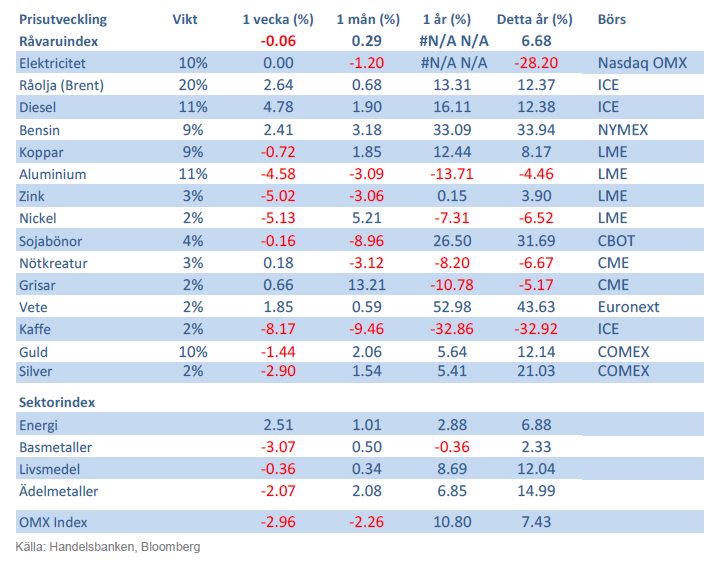
Handelsbankens råvaruindex består av de underliggande indexen för respektive råvara. Vikterna är bestämda till hälften från värdet av global produktion och till hälften från likviditeten i terminskontrakten.
[box]SHB Råvarubrevet är producerat av Handelsbanken och publiceras i samarbete och med tillstånd på Råvarumarknaden.se[/box]
Ansvarsbegränsning
Detta material är producerat av Svenska Handelsbanken AB (publ) i fortsättningen kallad Handelsbanken. De som arbetar med innehållet är inte analytiker och materialet är inte oberoende investeringsanalys. Innehållet är uteslutande avsett för kunder i Sverige. Syftet är att ge en allmän information till Handelsbankens kunder och utgör inte ett personligt investeringsråd eller en personlig rekommendation. Informationen ska inte ensamt utgöra underlag för investeringsbeslut. Kunder bör inhämta råd från sina rådgivare och basera sina investeringsbeslut utifrån egen erfarenhet.
Informationen i materialet kan ändras och också avvika från de åsikter som uttrycks i oberoende investeringsanalyser från Handelsbanken. Informationen grundar sig på allmänt tillgänglig information och är hämtad från källor som bedöms som tillförlitliga, men riktigheten kan inte garanteras och informationen kan vara ofullständig eller nedkortad. Ingen del av förslaget får reproduceras eller distribueras till någon annan person utan att Handelsbanken dessförinnan lämnat sitt skriftliga medgivande. Handelsbanken ansvarar inte för att materialet används på ett sätt som strider mot förbudet mot vidarebefordran eller offentliggörs i strid med bankens regler.
Analys
Tightening fundamentals – bullish inventories from DOE

The latest weekly report from the US DOE showed a substantial drawdown across key petroleum categories, adding more upside potential to the fundamental picture.

Commercial crude inventories (excl. SPR) fell by 5.8 million barrels, bringing total inventories down to 415.1 million barrels. Now sitting 11% below the five-year seasonal norm and placed in the lowest 2015-2022 range (see picture below).
Product inventories also tightened further last week. Gasoline inventories declined by 2.1 million barrels, with reductions seen in both finished gasoline and blending components. Current gasoline levels are about 3% below the five-year average for this time of year.
Among products, the most notable move came in diesel, where inventories dropped by almost 4.1 million barrels, deepening the deficit to around 20% below seasonal norms – continuing to underscore the persistent supply tightness in diesel markets.
The only area of inventory growth was in propane/propylene, which posted a significant 5.1-million-barrel build and now stands 9% above the five-year average.
Total commercial petroleum inventories (crude plus refined products) declined by 4.2 million barrels on the week, reinforcing the overall tightening of US crude and products.


Analys
Bombs to ”ceasefire” in hours – Brent below $70

A classic case of “buy the rumor, sell the news” played out in oil markets, as Brent crude has dropped sharply – down nearly USD 10 per barrel since yesterday evening – following Iran’s retaliatory strike on a U.S. air base in Qatar. The immediate reaction was: “That was it?” The strike followed a carefully calibrated, non-escalatory playbook, avoiding direct threats to energy infrastructure or disruption of shipping through the Strait of Hormuz – thus calming worst-case fears.

After Monday morning’s sharp spike to USD 81.4 per barrel, triggered by the U.S. bombing of Iranian nuclear facilities, oil prices drifted sideways in anticipation of a potential Iranian response. That response came with advance warning and caused limited physical damage. Early this morning, both the U.S. President and Iranian state media announced a ceasefire, effectively placing a lid on the immediate conflict risk – at least for now.
As a result, Brent crude has now fallen by a total of USD 12 from Monday’s peak, currently trading around USD 69 per barrel.
Looking beyond geopolitics, the market will now shift its focus to the upcoming OPEC+ meeting in early July. Saudi Arabia’s decision to increase output earlier this year – despite falling prices – has drawn renewed attention considering recent developments. Some suggest this was a response to U.S. pressure to offset potential Iranian supply losses.
However, consensus is that the move was driven more by internal OPEC+ dynamics. After years of curbing production to support prices, Riyadh had grown frustrated with quota-busting by several members (notably Kazakhstan). With Saudi Arabia cutting up to 2 million barrels per day – roughly 2% of global supply – returns were diminishing, and the risk of losing market share was rising. The production increase is widely seen as an effort to reassert leadership and restore discipline within the group.
That said, the FT recently stated that, the Saudis remain wary of past missteps. In 2018, Riyadh ramped up output at Trump’s request ahead of Iran sanctions, only to see prices collapse when the U.S. granted broad waivers – triggering oversupply. Officials have reportedly made it clear they don’t intend to repeat that mistake.
The recent visit by President Trump to Saudi Arabia, which included agreements on AI, defense, and nuclear cooperation, suggests a broader strategic alignment. This has fueled speculation about a quiet “pump-for-politics” deal behind recent production moves.
Looking ahead, oil prices have now retraced the entire rally sparked by the June 13 Israel–Iran escalation. This retreat provides more political and policy space for both the U.S. and Saudi Arabia. Specifically, it makes it easier for Riyadh to scale back its three recent production hikes of 411,000 barrels each, potentially returning to more moderate increases of 137,000 barrels for August and September.
In short: with no major loss of Iranian supply to the market, OPEC+ – led by Saudi Arabia – no longer needs to compensate for a disruption that hasn’t materialized, especially not to please the U.S. at the cost of its own market strategy. As the Saudis themselves have signaled, they are unlikely to repeat previous mistakes.
Conclusion: With Brent now in the high USD 60s, buying oil looks fundamentally justified. The geopolitical premium has deflated, but tensions between Israel and Iran remain unresolved – and the risk of missteps and renewed escalation still lingers. In fact, even this morning, reports have emerged of renewed missile fire despite the declared “truce.” The path forward may be calmer – but it is far from stable.
Analys
A muted price reaction. Market looks relaxed, but it is still on edge waiting for what Iran will do

Brent crossed the 80-line this morning but quickly fell back assigning limited probability for Iran choosing to close the Strait of Hormuz. Brent traded in a range of USD 70.56 – 79.04/b last week as the market fluctuated between ”Iran wants a deal” and ”US is about to attack Iran”. At the end of the week though, Donald Trump managed to convince markets (and probably also Iran) that he would make a decision within two weeks. I.e. no imminent attack. Previously when when he has talked about ”making a decision within two weeks” he has often ended up doing nothing in the end. The oil market relaxed as a result and the week ended at USD 77.01/b which is just USD 6/b above the year to date average of USD 71/b.

Brent jumped to USD 81.4/b this morning, the highest since mid-January, but then quickly fell back to a current price of USD 78.2/b which is only up 1.5% versus the close on Friday. As such the market is pricing a fairly low probability that Iran will actually close the Strait of Hormuz. Probably because it will hurt Iranian oil exports as well as the global oil market.
It was however all smoke and mirrors. Deception. The US attacked Iran on Saturday. The attack involved 125 warplanes, submarines and surface warships and 14 bunker buster bombs were dropped on Iranian nuclear sites including Fordow, Natanz and Isfahan. In response the Iranian Parliament voted in support of closing the Strait of Hormuz where some 17 mb of crude and products is transported to the global market every day plus significant volumes of LNG. This is however merely an advise to the Supreme leader Ayatollah Ali Khamenei and the Supreme National Security Council which sits with the final and actual decision.
No supply of oil is lost yet. It is about the risk of Iran closing the Strait of Hormuz or not. So far not a single drop of oil supply has been lost to the global market. The price at the moment is all about the assessed risk of loss of supply. Will Iran choose to choke of the Strait of Hormuz or not? That is the big question. It would be painful for US consumers, for Donald Trump’s voter base, for the global economy but also for Iran and its population which relies on oil exports and income from selling oil out of that Strait as well. As such it is not a no-brainer choice for Iran to close the Strait for oil exports. And looking at the il price this morning it is clear that the oil market doesn’t assign a very high probability of it happening. It is however probably well within the capability of Iran to close the Strait off with rockets, mines, air-drones and possibly sea-drones. Just look at how Ukraine has been able to control and damage the Russian Black Sea fleet.
What to do about the highly enriched uranium which has gone missing? While the US and Israel can celebrate their destruction of Iranian nuclear facilities they are also scratching their heads over what to do with the lost Iranian nuclear material. Iran had 408 kg of highly enriched uranium (IAEA). Almost weapons grade. Enough for some 10 nuclear warheads. It seems to have been transported out of Fordow before the attack this weekend.
The market is still on edge. USD 80-something/b seems sensible while we wait. The oil market reaction to this weekend’s events is very muted so far. The market is still on edge awaiting what Iran will do. Because Iran will do something. But what and when? An oil price of 80-something seems like a sensible level until something do happen.
-

 Nyheter4 veckor sedan
Nyheter4 veckor sedanUppgången i oljepriset planade ut under helgen
-

 Nyheter3 veckor sedan
Nyheter3 veckor sedanMahvie Minerals växlar spår – satsar fullt ut på guld
-

 Nyheter4 veckor sedan
Nyheter4 veckor sedanLåga elpriser i sommar – men mellersta Sverige får en ökning
-

 Nyheter2 veckor sedan
Nyheter2 veckor sedanOljan, guldet och marknadens oroande tystnad
-

 Analys4 veckor sedan
Analys4 veckor sedanVery relaxed at USD 75/b. Risk barometer will likely fluctuate to higher levels with Brent into the 80ies or higher coming 2-3 weeks
-

 Nyheter2 veckor sedan
Nyheter2 veckor sedanJonas Lindvall är tillbaka med ett nytt oljebolag, Perthro, som ska börsnoteras
-

 Analys3 veckor sedan
Analys3 veckor sedanA muted price reaction. Market looks relaxed, but it is still on edge waiting for what Iran will do
-

 Nyheter2 veckor sedan
Nyheter2 veckor sedanDomstolen ger klartecken till Lappland Guldprospektering


